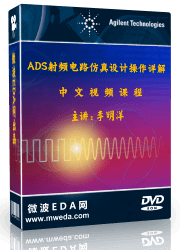- 易迪拓培训,专注于微波、射频、天线设计工程师的培养
Help in ADS regarding how to change material properties of ground plane?
I'm currently designing a photoconductive micro strip antenna, whose ground plane doesn't use conventional metal(copper), instead I'm using a lower conductivity material. Now when I try to optimise the printed patch, it asks me to give a certain value for conductivity (MSUB), which is for the radiating patches and strip lines. But couldn't find any option to input the value for the second conductive material which is the ground plane. And change the properties of ground plane does change the impedance matching of the antenna, which I verified in CST.
Hence if any ADS expert could suggest me how to change the conductivity of ground plane (not the stripline) that would be really helpful
Many Thanks!
I'm confused. MSUB is used for circuit simulation and not for EM.
For Momentum EM, materials are defined in the Momentum substrate definition. You have not mentioned which ADS version you use, so I assume it is ADS 2011 or newer. Define the conductor material for your bottom ground plane in the substrate editor: Technology > Material Definitions. Then, select the infinite bottom ground plane in your substrate and assign this material that you have defined.
First of all I would like to thank volker@muehlhaus for your reply.
Now, I'm currently using ADS 2013, and have designed a powerdivider circuit along wiith patches in Schematic section using T-Lines microstrip. My circuit is perfectly matched. Now what I wanted to know is how do I use this printed patch on a substrate along with low conductive ground plane on ADS? And I also wanted to optimise the printed patch on the substrate of the microstrip antenna by taking into consideration the low conductivity of the ground plane material, because the printed patch that shows S11 < -50dB in schematics gives a mismatched circuit when I want to simulate the same design in CST.
And also I agree with you that MSUB is used for circuit simulation, but since it asks for dielectric of the material as well as TanD of the metal stripline and patches, I thought it might as well take the ground plane into consideration. Hence if I want to consider the ground plane with different conductivity I need to create the material as you said (Technology > Material Definitions. Then, select the infinite bottom ground plane in your substrate and assign this material that you have defined), but on which platform? Will I be still using schematic or should I use generate layout? And also in the schematic section can I do EM simulation, if not how do I use this impedance matched printed circuit on a substrate and a low conductive ground plane?
If you have a preferred solution for this please let me know. I shall be really grateful if you could help me with this.
Many Thanks
First of all I would like to thank volker@muehlhaus for your reply.
Now, I'm currently using ADS 2013, and have designed a powerdivider circuit along wiith patches in Schematic section using T-Lines microstrip. My circuit is perfectly matched. Now what I wanted to know is how do I use this printed patch on a substrate along with low conductive ground plane on ADS? And I also wanted to optimise the printed patch on the substrate of the microstrip antenna by taking into consideration the low conductivity of the ground plane material, because the printed patch that shows S11 < -50dB in schematics gives a mismatched circuit when I want to simulate the same design in CST.
And also I agree with you that MSUB is used for circuit simulation, but since it asks for dielectric of the material as well as TanD of the metal stripline and patches, I thought it might as well take the ground plane into consideration. Hence if I want to consider the ground plane with different conductivity I need to create the material as you said (Technology > Material Definitions. Then, select the infinite bottom ground plane in your substrate and assign this material that you have defined), but on which platform? Will I be still using schematic or should I use generate layout? And also in the schematic section can I do EM simulation, if not how do I use this impedance matched printed circuit on a substrate and a low conductive ground plane?
If you have a preferred solution for this please let me know. I shall be really grateful if you could help me with this.
Many Thanks
I'm even more confused now. What I described requires Momentum (or Momentum co-simulation). You mentioned an antenna, which has no circuit model and can't be simulated with circuit models. So obviously you are already using EM simulation with Momentum for the antenna part, or possibly for all layout? Then, where exactly did you get lost?
Hi volker@muehlhaus,
If what I've written confuses you, I'll lay it out straight. I've created a low conductive material in the (Technology > Material Definitions) section and named it conductor_1. How do I use conductor_1 in T-line microstrip of the schematic diagram? The diagram is a matched-printed microstrip line, should I go to (Layout> Generate layout) of the schematic and assign the material for ground somewhere? And what is Momentum co-simulation? How do you generate it? Is it a special feature in ADS. I apologize for my ignorance, since I'm new with ADS.
No. The materials defined in the technology are used for the EM substrate definitions.
You mentioned an antenna, and for that, schematic level simulation is not applicable anyway. The correct method is to analyze the antenna with EM (Momentum), and then use the EM results in schematic simulation.
The input for EM simulation is a layout that you can draw from polygons (arbitrary layout) or from pre-defined layout elements.
The output from EM simulation is S-parameters, which you can use in different ways: S1P data block or emModel.
Schematic simulation is good for cascading pieces of non-radiating transmission lines, where ADS has electrical models for each of these pieces. Schematic simulation is not approriate for radiating structures -> antennas. For antennas, you need EM simulation.
You can mix model based schematic simulation (for the feed network) and EM results (for the antenna) in your schematic. For the EM part, you then need to have a layout and an EM substrate defintion. In that EM substrate definition, you can define the bottom conductor as you wish. That's what I mentioned in post #2.
Here's an ADS tutorial:
http://www.rf-design-tips.com/ads-qu...line-training/
EM is covered in the "Day 3" video
http://www.rf-design-tips.com/ads-qu...line-training/
申明:网友回复良莠不齐,仅供参考。如需专业帮助,请学习易迪拓培训专家讲授的ADS视频培训课程。
上一篇:S parameter an cadence spetre and ads
下一篇:S2P data from HFSS to ADS mismatch
ADS中文视频培训教程 | More...
 国内最全面、最专业的Agilent ADS培训课程,可以帮助您从零开始,全面系统学习ADS设计应用【More..】
国内最全面、最专业的Agilent ADS培训课程,可以帮助您从零开始,全面系统学习ADS设计应用【More..】
- Agilent ADS教学培训课程套装
- 两周学会ADS2011、ADS2013视频教程
- ADS2012、ADS2013射频电路设计详解
- ADS高低阻抗线微带滤波器设计培训教程
- ADS混频器仿真分析实例视频培训课程
- ADS Momentum电磁仿真设计视频课程
- ADS射频电路与通信系统设计高级培训
- ADS Layout和电磁仿真设计培训视频
- ADS Workspace and Simulators Training Course
- ADS Circuit Simulation Training Course
- ADS Layout and EM Simulation Training Course
- Agilent ADS 内部原版培训教材合集









 沪公网安备 31011202014168号
沪公网安备 31011202014168号
 1427313829
1427313829 旺旺在线
旺旺在线 Skype Online
Skype Online 13761612886
13761612886 官方淘宝店
官方淘宝店
